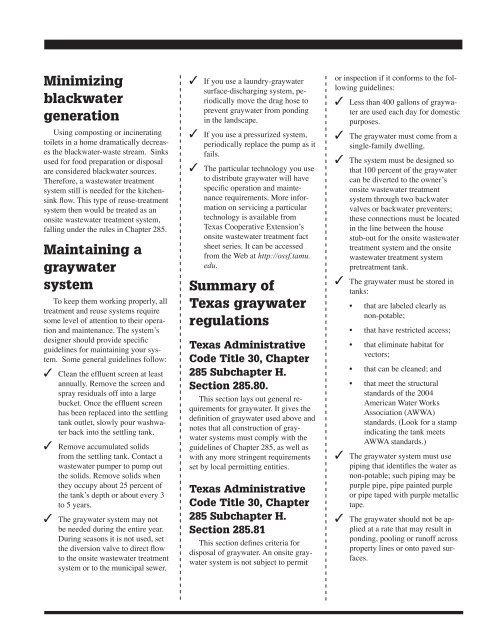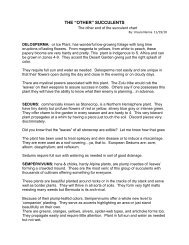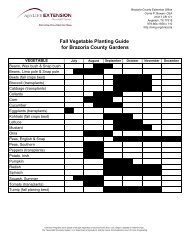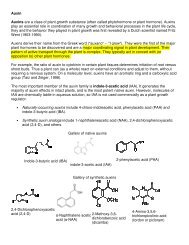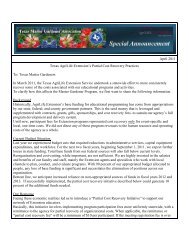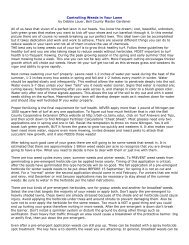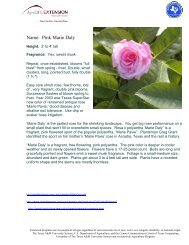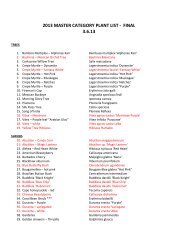Graywater - Texas Master Gardeners Association
Graywater - Texas Master Gardeners Association
Graywater - Texas Master Gardeners Association
Create successful ePaper yourself
Turn your PDF publications into a flip-book with our unique Google optimized e-Paper software.
Minimizing<br />
blackwater<br />
generation<br />
Using composting or incinerating<br />
toilets in a home dramatically decreases<br />
the blackwater-waste stream. Sinks<br />
used for food preparation or disposal<br />
are considered blackwater sources.<br />
Therefore, a wastewater treatment<br />
system still is needed for the kitchensink<br />
flow. This type of reuse-treatment<br />
system then would be treated as an<br />
onsite wastewater treatment system,<br />
falling under the rules in Chapter 285.<br />
Maintaining a<br />
graywater<br />
system<br />
To keep them working properly, all<br />
treatment and reuse systems require<br />
some level of attention to their operation<br />
and maintenance. The system’s<br />
designer should provide specific<br />
guidelines for maintaining your system.<br />
Some general guidelines follow:<br />
Clean the effluent screen at least<br />
annually. Remove the screen and<br />
spray residuals off into a large<br />
bucket. Once the effluent screen<br />
has been replaced into the settling<br />
tank outlet, slowly pour washwater<br />
back into the settling tank.<br />
Remove accumulated solids<br />
from the settling tank. Contact a<br />
wastewater pumper to pump out<br />
the solids. Remove solids when<br />
they occupy about 25 percent of<br />
the tank’s depth or about every 3<br />
to 5 years.<br />
The graywater system may not<br />
be needed during the entire year.<br />
During seasons it is not used, set<br />
the diversion valve to direct flow<br />
to the onsite wastewater treatment<br />
system or to the municipal sewer.<br />
If you use a laundry-graywater<br />
surface-discharging system, periodically<br />
move the drag hose to<br />
prevent graywater from ponding<br />
in the landscape.<br />
If you use a pressurized system,<br />
periodically replace the pump as it<br />
fails.<br />
The particular technology you use<br />
to distribute graywater will have<br />
specific operation and maintenance<br />
requirements. More information<br />
on servicing a particular<br />
technology is available from<br />
<strong>Texas</strong> Cooperative Extension’s<br />
onsite wastewater treatment fact<br />
sheet series. It can be accessed<br />
from the Web at http://ossf.tamu.<br />
edu.<br />
Summary of<br />
<strong>Texas</strong> graywater<br />
regulations<br />
<strong>Texas</strong> Administrative<br />
Code Title 30, Chapter<br />
285 Subchapter H.<br />
Section 285.80.<br />
This section lays out general requirements<br />
for graywater. It gives the<br />
definition of graywater used above and<br />
notes that all construction of graywater<br />
systems must comply with the<br />
guidelines of Chapter 285, as well as<br />
with any more stringent requirements<br />
set by local permitting entities.<br />
<strong>Texas</strong> Administrative<br />
Code Title 30, Chapter<br />
285 Subchapter H.<br />
Section 285.81<br />
This section defines criteria for<br />
disposal of graywater. An onsite graywater<br />
system is not subject to permit<br />
or inspection if it conforms to the following<br />
guidelines:<br />
Less than 400 gallons of graywater<br />
are used each day for domestic<br />
purposes.<br />
The graywater must come from a<br />
single-family dwelling.<br />
The system must be designed so<br />
that 100 percent of the graywater<br />
can be diverted to the owner’s<br />
onsite wastewater treatment<br />
system through two backwater<br />
valves or backwater preventers;<br />
these connections must be located<br />
in the line between the house<br />
stub-out for the onsite wastewater<br />
treatment system and the onsite<br />
wastewater treatment system<br />
pretreatment tank.<br />
The graywater must be stored in<br />
tanks:<br />
• that are labeled clearly as<br />
non-potable;<br />
• that have restricted access;<br />
• that eliminate habitat for<br />
vectors;<br />
• that can be cleaned; and<br />
• that meet the structural<br />
standards of the 2004<br />
American Water Works<br />
<strong>Association</strong> (AWWA)<br />
standards. (Look for a stamp<br />
indicating the tank meets<br />
AWWA standards.)<br />
The graywater system must use<br />
piping that identifies the water as<br />
non-potable; such piping may be<br />
purple pipe, pipe painted purple<br />
or pipe taped with purple metallic<br />
tape.<br />
The graywater should not be applied<br />
at a rate that may result in<br />
ponding, pooling or runoff across<br />
property lines or onto paved surfaces.


